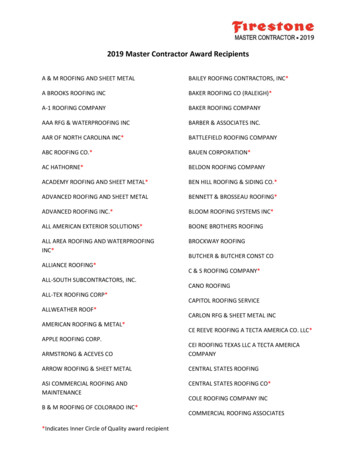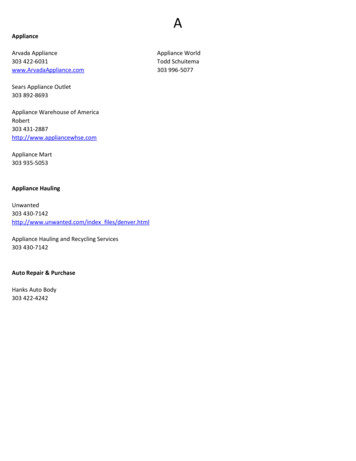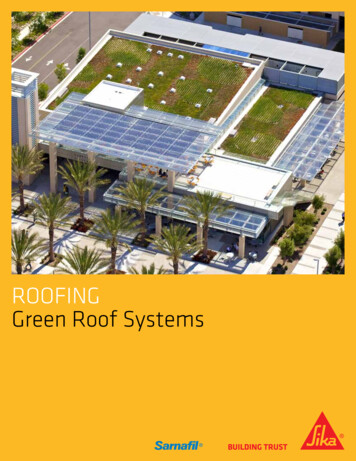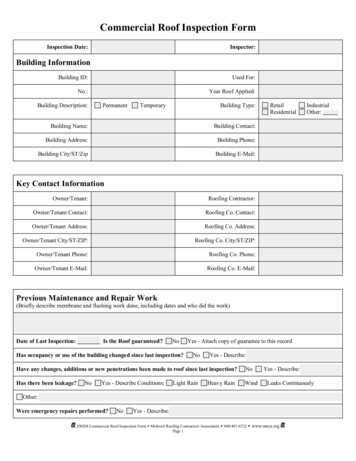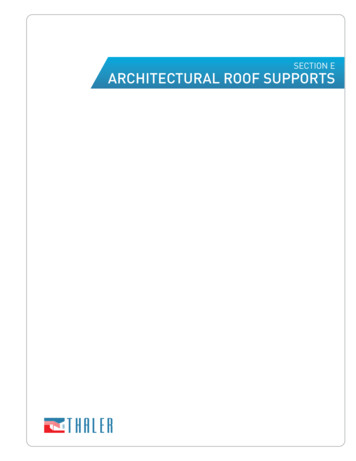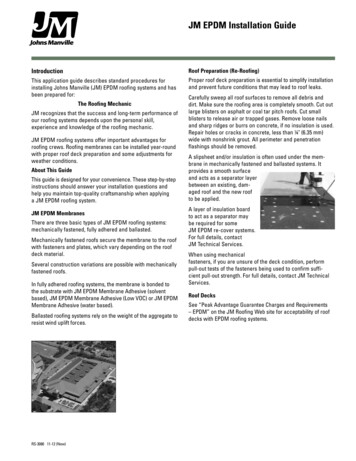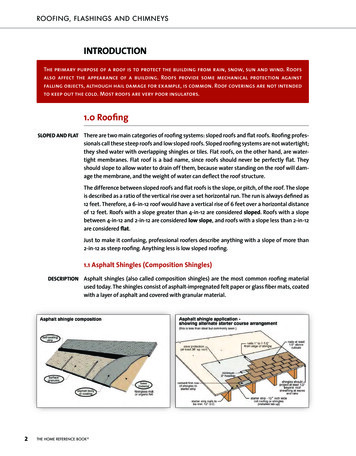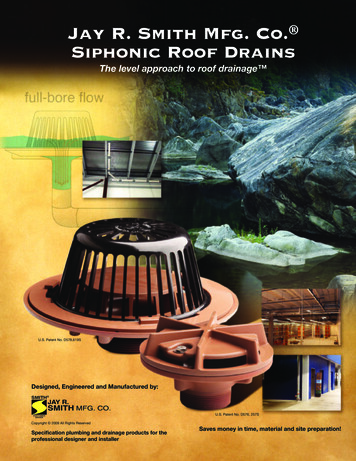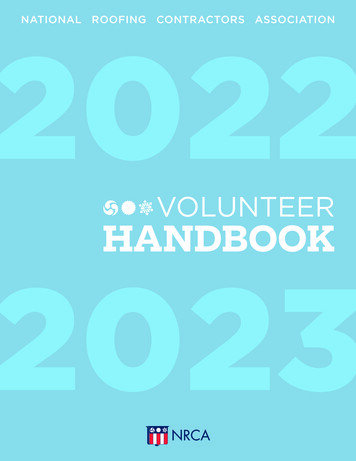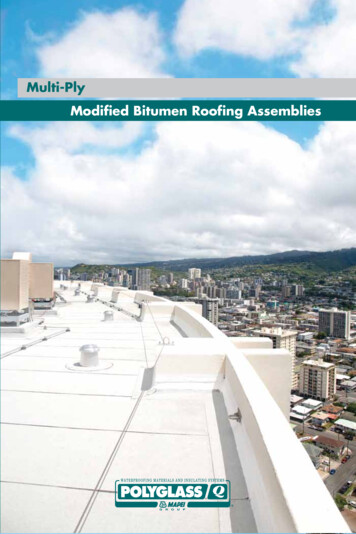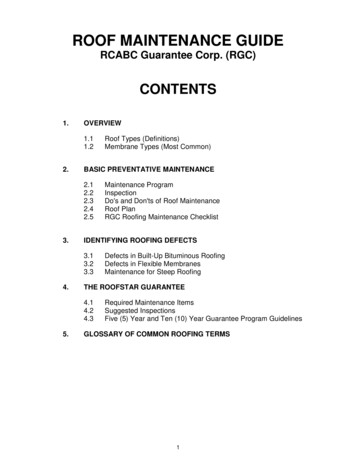
Transcription
ROOF MAINTENANCE GUIDERCABC Guarantee Corp. (RGC)CONTENTS1.OVERVIEW1.11.22.BASIC PREVENTATIVE MAINTENANCE2.12.22.32.42.53.Defects in Built-Up Bituminous RoofingDefects in Flexible MembranesMaintenance for Steep RoofingTHE ROOFSTAR GUARANTEE4.14.24.35.Maintenance ProgramInspectionDo's and Don'ts of Roof MaintenanceRoof PlanRGC Roofing Maintenance ChecklistIDENTIFYING ROOFING DEFECTS3.13.23.34.Roof Types (Definitions)Membrane Types (Most Common)Required Maintenance ItemsSuggested InspectionsFive (5) Year and Ten (10) Year Guarantee Program GuidelinesGLOSSARY OF COMMON ROOFING TERMS1
1.OVERVIEWThe most important reason for establishing a program of regular roof maintenance is to protect theowner's investment. A properly executed maintenance program will add years to the life of theroof by detecting minor problems before they become major, as well as providing better protectionfor, and avoiding interruption of, the internal functions of the building.A roof system is exposed to all manner of chemical and physical stress. The long term effects ofthese forces are called "Normal Aging". In reality, small isolated problems caused through abuse,stress concentration, inadequate ventilation, error, or other factors result in a shortened lifespan ofthe roofing system.Small problems or defects, if not detected and repaired, inevitably become major problemsaffecting the performance of the whole roof system.Roofs represent approximately 5 to 7% of capital building costs - but roofs cover 100% of thebuilding and its contents.1.1ROOF TYPES (DEFINITIONS)MEMBRANE ROOFINGConventional UninsulatedRoof membrane is installed directly to the deck (usually wood or concrete), and is exposed to theweather. There is no insulation directly below the membrane. In a wood deck of this type theinsulation, if used, is typically installed in the supporting joist space, which must be cross-vented.Conventional InsulatedRoof membrane is installed directly over insulating materials, which are installed on the deck(wood, concrete or steel). The membrane is exposed to the weather.Protected (or Inverted) MembraneRoof membrane is installed directly to the deck (wood, concrete or overlaid steel). Extrudedpolystyrene is installed over the membrane covered by filter fabric and appropriate ballast. Ballastis required to counteract insulation flotation and wind uplift, and to provide ultraviolet resistance forthe insulation. A modified protected membrane includes insulation both above and below themembrane. It is often used to provide slope to the membrane in order to improve drainage or tomove the dew point away from the membrane.STEEP ROOFINGIn the context of this guide, steep roofing may be defined as roofs with asphalt shingles, cedarshakes or shingles or metal roofing on slopes that exceed 1:6 (2" in 12").2
1.2MEMBRANE TYPES (MOST COMMON)Built-Up Roofing (also called "Tar & Gravel" or "BUR")A continuous, relatively inflexible roof assembly consisting of plies (usually 3 or 4) of saturatedfelts or fabrics between which layers of bitumen (asphalt, pitch, or modified rubberized asphalt) isapplied. The roof is usually surfaced with gravel to provide ultraviolet protection.Flexible MembranesFlexible membranes encompass a large number of unique membranes installed in single or multiply applications. The materials may be bituminous or non-bituminous and offer a wide choice ofphysical properties and performance.The key point with these membranes — from a maintenance and repair standpoint — is that eachtype is unique. The building owner must be aware of the specific type and product in place inorder to know what maintenance is required and what specialized repair materials and methodsshould be used.Remember: "This Roof May Be Different"Common Types of Flexible Membranes are:Modified BitumenA generic description for pre-manufactured sheet membranes consistingof asphalt, modified with a polymer, which improves the physicalproperties of the asphalt and coated on a reinforcing mat or carrier.Different polymers offer different physical properties. Sheets may beinstalled either in hot asphalt or by heating with a propane torch, and insome cases they may be self-adhesive. Applications normally consist of2 plies but may be a single ply in certain well sloped applications.Modified Bitumen Membranes are used in all roof types.EPDM (Ethylene PropyleneDiene Monomer)A generic description for synthetic rubber sheet membranes. Appliedonly in single-ply applications on all roof types. Seams are accomplishedwith proprietary adhesives.PVC (Polyvinyl Chloride andTPO (Thermoplastic polyolefin) Generic descriptions for a plastic sheet membrane. Applied in singleply applications on all roof types. Seams are accomplished by fusioneither with solvent or hot-air welding techniques.Although these are the most commonly used generic flexible membranes, there are other types on themarket (each of which, as mentioned, requires special knowledge and techniques). Make sure you knowwhat you are dealing with.3
2.BASIC PREVENTIVE MAINTENANCE2.1MAINTENANCE PROGRAMA preventive maintenance program is simply a program of scheduled inspections and subsequentcorrective action. The purpose is to maximize the life expectancy of the roofing system, thusproviding maximum protection to building and contents and minimizing overall costs.The basic elements of a preventive maintenance program for roofs are: Regular visual inspections to determine the current condition of the roof membrane andflashings. Immediate repair of any defect before it allows moisture to enter the roof system or buildinginterior. Non-destructive moisture detection to determine if moisture has infiltrated into the insulationof the roof system.A vital part of the condition of the roof system is whether or not the insulation remains dry. A roofmay appear to be in excellent condition from the surface, but may have areas of saturatedinsulation, which severely affect the thermal efficiency of the roof.Non-destructive moisture detection of roof systems has developed into a sophisticated techniquethat can provide accurate analysis of roof insulation condition. Two commonly used systems arenuclear meter and infrared thermography. Both systems require trained skilled operators, specificweather conditions, specific roof types, and professional analysis. Visual inspection by a trainedperson is the key to a successful maintenance program.2.2INSPECTIONRoofs should be inspected at least twice a year — spring and fall — and also after any significantweather or construction event.The inspection should be preceded by the preparation of a detailed roof plan on which all defectsor notes can be marked. If the inspection indicates that more than minor work is required, aninspection checklist is necessary to ensure thoroughness. Call your professional roofingcontractor to perform the required maintenance work.A typical roof plan and an inspection checklist are included in this guide for your convenience.Begin the inspection by looking at the underside of the deck, if accessible, and also at the outsideof the building. Look for cracks, stains, rusting, watermarks, efflorescence, wet spots, spalledmortar etc. or other signs of excessive moisture or deterioration. The observations may give cluesto not only roofing problems but also other conditions affecting the performance of the buildingenvelope.The final and most important part is inspecting the roof itself. The keys to a competent roofinspection are thoroughness and attention to detail — be prepared to get dirty!4
2.3 DO'S AND DON'TS OF ROOF MAINTENANCEDO's: Do be aware that wise maintenance will prolong the life of any roof — even the best of them. Do perform inspections at least twice a year, preferably at the end of winter and right aftersummer, when roofs have passed through the periods of severest stress. Do conduct additional inspections immediately after unusual occurrences such as extremelyheavy rains, high winds, hail, nearby fires, explosions, etc. Do check the building exterior for settlement or movement. Cracks in the wall are a warning ofpossible cracks in the roofing and flashing. Are overhangs, cornices, fascias and edging in goodcondition? Are gutters and downspouts satisfactory? Breaks in roof edge elements can causeleaks and also let wind get under the roofing membrane and cause blow-offs. Damaged orclogged gutters, roof drains, and downspouts can cause water back up on the roof. Do be certain that equipment servicemen going on the roof are warned against penetrating ordropping tools on the roof. They should be accompanied by your trained maintenance man toensure no damage to the roof assembly occurs. Do assure that your roof is kept clean and free from debris. Do recognize that exposure of roof felts (bare spots) on a gravel surfaced roof can lead to quickdeterioration. This requires immediate attention by qualified personnel. Do be advised that flashings, gum pans, gravel stops and all other roof penetrations are thesource of most leaks. Pay extreme and careful attention to these items.DON'TS: Don't allow unqualified personnel to maintain your roofs. Don't allow traffic on your roof unless accompanied by your informed maintenance man. Don't allow equipment servicemen to penetrate your roof without being certain that qualifiedpersonnel flash the penetrations. If your roof is covered by a RoofStar Guarantee, RGC or themembrane manufacturer should be notified prior to cutting the roof or altering it in any manner.5
WHEN IT'S TIME TO REROOF:DON'TS: Don't permit products of unproven quality to be used on your roof. Don't be taken in by "Cure-All" products, which can be applied by anyone. Don't take bids on projects without adequate, uniform specifications. Don't reroof over an existing roof unless a careful evaluation is made, and a qualified consultant orstandards authority gives prior approval. Don't expect a guarantee to keep the water out of your buildings. Guarantees do not cover manyof the problem areas of your roof. Don't think that the lowest price is always the best. Be certain you will not be faced with a numberof change order requests for extras after a project is awarded. Don't deal with firms who cannot stand behind their work and will not be available when you needthem. Remember that no product is better than the applicator.DO's: Do hire a professional roofer. Do call a member of RCABC. Do request the RoofStar Guarantee Do benefit from:Independent InspectionsRGC Accepted MaterialsRGC Guarantee Standards6
2.4 ROOF PLANEach roof covered by the RoofStar Guarantee comes with a complete "Roof System Record",which includes a roof plan and a copy of this maintenance guide. If you set up your own roofmaintenance file, you should prepare a roof plan using the following as a guide.Key To Potential Roof Top ProblemsABCDEFGHJKLMNPRSTUVWX- Ponded Water- Skylight- Roof Drain- Vent Pipe- Vent or Fan- Ladder- Walkway- Hatch- Flag Pole- Sign Support- Air Conditioning Unit- Pitch Pan- Chimney & Flashing- Parapet or Fire Wall- Coping- Base Flashing- Cap Flashing- Expansion Joint Cover- Down Spout & Leader- Fascia & Gravel Stop- Roof Vent7
2.5ROOFING MAINTENANCE CHECKLIST (page 1)DATEBUILDINGLOCATIONINSPECTORProblemO.K.MajorI. ROOF CONDITIONA.General AppearanceDebrisDrainagePhysical DamageGeneral ConditionNew Equipment / AlterationsOtherB.Surface ConditionBare Spots in GravelAlligatoring / CrackingSlippageOtherC.Membrane ConditionBlistering / Splitting / RidgingPhysical DamageOtherII. FLASHING CONDITIONA.Membrane FlashingPhysical DamageDeterioration / Blistering /Open LapsAttachmentOtherB.Metal FlashingsPhysical DamageAttachment / te ofRepair
2.5ROOFING MAINTENANCE CHECKLIST (page 2)ProblemO.K.MajorI. ROOF PENETRATIONSA.Equipment1.2.Open LapsPuncturesAttachmentOtherB.Equipment HousingC.Equipment OperationD.Roof Jacks / VentsE.Roof DrainsTypeConditionQuantityOverflowsIV. EXPANSION JOINT COVERSV. GUM PANSFill Material ShrinkageOtherVI. OTHER OBSERVATIONS1.2.3.9MinorObservationDate ofRepair
3IDENTIFYING POTENTIAL ROOFING PROBLEMS OR DEFECTS3.1DEFECTS IN BUILT-UP BITUMINOUS ROOFINGDefect ObservedPossible CauseRequired MaintenanceBlueberry blisters insurface of bitumenExpansion of volatile fractions ofbitumen or of air or water, in sunnyweather. More common with lowmeltpoint bitumens particularly withheavy coatings and poor gravelcover.Initially apply additional opaquegravel. If many blisters occur andare broken to expose felts, recoatwith bitumen and apply heavy layerof opaque gravel.Expansion in sunny weather ofentrapped air or water in areas ofpoor adhesion.Cut blister, trim excess material, readhere and patch. Heavy layer ofopaque gravel may help to preventre-occurrence.Blisters betweenlayers of feltBlisters betweenfelt membrane andsubstrateExpansion in sunny weather ofentrapped air or water, usually overdecks with concrete fills, or withwetted insulation.Ridging or bucklingMovement of either the felts or thedeck or substrate under moistureor thermal effects, causing longripple ridges especially where feltnot well bonded, often overinsulation or deck joints.Lifting at laps(fishmouths)CrackingbreakingorFelt penetrating toppour and gravel atlapsDeterioration due topondingPoor adhesion initially due towrinkled felt or workmanship, orpulling as a result of blister orridging formation.Breaks in unsupported felt.Cracking of blisters or ridges bytraffic. Breaks at sharp bends infelt.Poor workmanship initially resultingin poor adhesion. Curling of feltedges when left exposed too longduring construction.Improper design with no, orinadequate, slopes to drains.Drains at high points on roof orobstructed.10Where possible, cut blister, trimexcess material, re-adhere andpatch. Venting (if possible) mayhelp. Heavy layer of opaque gravelmay help.Usually little can be done. If of smallsize and elevation, a heavyapplication of gravel will make it lessconspicuous and give someprotection. If wide and high, cuttingand relaying is necessary. May reoccur if movement persists.Re-adhere if not wrinkled. Wherewrinkles or fishmouths, cut, removeexcess material, re-adhere andpatch.Cut out, provide support and patch.Cut blister, re-adhere felts andpatch. Round off and patch.Re-adhere if possible, or cut away.Cover with bitumen and gravel. Feltedge must not be exposed.Clear drains. Use additionalbitumen and gravel in the low areas,which may help to limit damage.Add additional drains if possible.
Defect ObservedPossible CauseRequired MaintenanceBare spots fromloss of gravelGravel applied in adverse weather.Too thin a layer of too-fine gravel.Inadequate adhesion of gravel atedges and corners.Recoat with adequate bitumen andapply a heavy dressing of properlysized gravel.General weatherdeterioration ofbitumenInadequate gravel or other surfaceprotection, inadequate bitumen,lack of maintenance.Flashing failuresInadequate allowance formovement. Inadequate fixing intoreglets. Poor adhesion orinadequate protection of strippingfelts. Movement at roof drains orvent pipes. Damage to capping atparapets and expansion joints.Loss of mastic or damage to masticpans.PondingInsufficient slope to drains.Building settlement.Structural movement.If felt strength affected, cannot berejuvenated with coatings. If feltsnot affected, apply new bitumen andgravel protection.Repair with allowance.Re-fix and caulk. Apply new feltsand protect. Allow movement andrepair. Repair to allow movementand shed water. Repair, add freshmastic, counter-flash.Where ponding cannot beeliminated, pumping is sometimesused to remove water from roof afterrain. Add new drains if possible.WindscourInadequate adhesion of gravel.Ballast too small for application.Alligator CrackingSlippageSealingWhere bare spots are due to windscour at corners, it may benecessary to use concrete slabs asthe protective cover in the areaaffected.When alligator cracking of surfacebitumen occurs on bare spots or onsmooth-surface roofs withoutprotective covering, adding morebitumen is only a short-termremedy; cracks will recur.Remove alligatored material andrecoat if possible. Use a feltreinforced recoating. Protect therecoating with gravel or a paintcoating.Slippage of gravel, felts orcomplete membrane on slopingroofs is due to improper choice ofbitumen, thick layers of bitumen,phased construction, excessivelyheavy protective covering, lack ofmechanical fastening whererequired.If not too severe, may correct itselfby change in bitumen properties onexposure. Mechanically fasten ifpossible, or remove and reroof withstiffer bitumen and adequatefastening of components.Deterioration due to U.V.degradation, ozone or otheratmospheric contaminants,physical abuse, normal wear andtear etc.11For skylights and similar roofconstruction, new gasketing orsealants may be required.
3.2DEFECTS IN FLEXIBLE MEMBRANESThe most important thing to remember when dealing with maintenance or repair toany flexible membrane (be it TPO, PVC, EPDM or modified bitumen) is that youmust understand and know the specific system, its components and required repairmaterials and techniques. Do not mix and match materials without specificinstructions from the membrane manufacturer.3.2.1 Modified Bitumen MembranesModified bitumens are in many ways similar to built-up roofing for inspections,maintenance and repairs. Similar defects may appear such as blisters, ridging,buckling and fishmouths. Follow the manufacturer's published repair methods.Particular attention should be given to seam inspection especially at endlaps and "T" joints where moisture may penetrate and migrate.Severe granule loss may result in ultraviolet degradation of the sheetmembrane. Recoat the bare spots with new granules in adhesive.Watch for chemical contamination near roof top units and vents.Watch for deterioration or slipping of base flashings.Wrinkles are not uncommon to the systems; provided they are small andisolated and do not cause an opening across a lap seam, they may not affectperformance.3.2.2 EPDM, TPO and PVC Single Ply MembranesReferring to the checklist, report the general appearance of the roof and thesurface conditions of the membrane.General appearance is primarily a function of housekeeping. Debris, poordrainage, or ponding may be evidence of physical damage.Any discolouration, cracking or splitting, as well as punctures, should be notedand repaired.Seams should be observed for open joints, fishmouthing or ridging.On fully-adhered systems, it is important to note any unadhered areas. Onmechanically-fastened systems, a check should be made to be sure that thereis no evidence of fasteners backing out or popping. On ballasted systems, theweight and depth of stone ballast should be checked against the designspecifications.Any signs of scouring should be noted and all gravel redistributed evenly.If increased foot traffic becomes necessary, be sure to provide walkways.12
The following troubleshooting guide for TPO, PVC and EPDM membranes identifies somedefects and the possible causes.Defect ObservedPossible CauseDiscolouration of MembraneChemical or atmospheric contaminationCracking, crazing, or splitting ofmembranePossible defective membrane. Callmanufacturer immediately.Fishmouthing or open jointsImproper seam welding or adhesive.Loss of adhesion in fully-adheredsystemInterlaminar separation between insulationand facing indicating failure of insulation.Separation between membrane andinsulation indicating improper application ofadhesive. Call manufacturer immediately.Loose fastening in mechanicallyfastened systemFasteners not properly installed. Fastenerstoo short. Buckling, warping, shifting orcorrosive deterioration of deck or structure.Heavy foot traffic.Movement of ballast in loosely laidsystemBallast too small for wind uplift conditions.Foot traffic or vandalism.Ridging or buckling of membrane atinsulation jointsMovement of substrate due to moisture orthermal effects.3.3MAINTENANCE FOR STEEP ROOFINGDo keep drains and gutters clean.Foot traffic on steep roofs should be minimized both for safety reasons and toavoid physical damage.Granule erosion on asphalt shingles will lead to early deterioration of theshingle.Caulking of flashings must be regularly inspected and maintained.Improper ventilation of attic spaces may result in curling and blistering/bucklingof asphalt shingles.Install zinc strips to prevent moss build-up. Power washing the roof removesmoss and other debris but may erode granules on asphalt shingles, and mayalso promote premature degradation of cedar roofing.If asphalt shingle tabs are loose, re-tab with a cement recommended by theshingle manufacturer.13
CEDAR SHAKE & SHINGLE MAINTENANCE Ensure ventilation is available, year round. Areas with louvers, ridge vents,roof vents, and soffit vents need to be kept clear and never blocked off.Adequate ventilation ensures heat and moisture do not build up in the atticarea. Adequate ventilation also prevents water from accumulating at thebottom of the roof and then freezing (ice damming). Zinc or copper strips nailed at the ridge cap can be effective to control moss.Reaction between rain and the zinc or copper forms a mild solution that iscarried down sections of the roof. The optional use of these strips can beeliminated if you are using preservative treated cedar. Overhanging branches should be kept trimmed away from the roof. This willprevent leaves, small branches and other debris from building up and keepingthe roof wet. Gutters and downspouts need to be cleaned regularly, usually in the spring andfall. Downspouts (leaders) should run directly to the ground or to another gutterbelow. Never let a downspout drain directly onto a lower roof surface. Do not allow leaves, branches or other debris to build up on the roof. Bothsurface areas and keyways (spaces between shakes and shingles) need to bekept clear. Cedar needs to breathe, and therefore needs to be kept clean. High-pressure power washing will cause significant roof damage and istherefore not recommended. Garden hose pressure and a soft bristle brushcan easily remove most debris. Topical treatment of installed cedar roofing is not recommended. Manytreatment products may damage cedar roofs. Products that make erroneousclaims of 10-year effectiveness, provide fire-retardant claims, are a sealant,waterproofer or plasticizer and should not be used on cedar roofing.CEDAR REPAIRSIt is natural to expect some replacement of shakes or shingles as cedar roofsmature. It is possible to replace and repair parts of a cedar roof. Individual cedarshakes or shingles can be replaced with matching products by trained roofers.Contact an RCABC professional roofing contractor for your cedar repairs ormaintenance requirements.14
4THE ROOFSTAR GUARANTEEFive (5) Year and Ten (10) Year RoofStar Guarantees are unique third partyguarantees that cover workmanship and materials, including the flashing. Jobsguaranteed by RGC require that work is:erformed to RGC Guarantee Standardspplied by an RCABC member contractorthe specificationsnspected by an RGC accepted independent inspection firmnclude only RGC accepted materials and systems4.1REQUIRED MAINTENANCE ITEMSIn order to maintain the validity of a RoofStar Guarantee, the building owner mustproperly maintain:Drains, Gutters and DownspoutsClear away any debris that may impede their function. In addition, if they areclogged and cannot be readily cleared, get professional help. Make sure that anydrain screens installed are still in place and functioning as intended.Gravel Surface or Ballast ErosionIf the gravel has been eroded in certain areas, the unprotected bitumen coating willstart to deteriorate. This erosion is common in corners of the roof that face theprevailing winds. Other causes are foot traffic, forced air discharge from ventilators,ice action, and water spillage from higher roof elevations washing gravel away.The eroded areas should be regravelled as soon as possible.RegletsThese joints are designed to be the first line of defence against water penetration.Proper caulking should always be maintained in these reglets.Caulking of Metal FlashingCaulking of joints in metal flashings such as copings, counter flashing, roof topunits, curbs, expansion joints etc., requires regular inspection, cleaning andrecaulking, or replacement caulking. Always use a caulking material that you havechecked out to be compatible with all components in contact with the caulking.Gum Pans / Pitch PocketsA potential source of trouble, these high maintenance items should always be filledand "crowned" with roofing cement or compatible sealant to shed water. Theirwaterproofing ability depends on keeping them full and free of cracks.15
Plumbing CapsCheck to make sure plumbing caps on vents are in place. Replace if necessary.Do not just hammer or bend lead stacks. Use the proper cap.Insulation BoardsIn a protected membrane assembly, the insulation and ballast system may bedesigned to "float" under heavy rainfall conditions. If, under these circumstances,some of the gravel ballast is displaced and the scrim sheet is exposed, ballast canbe added or moved to prevent floatation and to provide cover. Cautionary Note: Ifballast is added, ensure that the added weight does not compromise the integrity ofthe roof structure. If there is any doubt at all, contact a structural engineer for aprofessional opinion.Roof TrafficIt is important to ensure that maintenance personnel who require access to roof-topequipment do not cause any damage while working on the roof. A roof shouldnever be used as a patio or sun deck unless proper protection has been provided.In addition, roof-top equipment and protrusions such as ventilators, plumbingstacks, etc., should never be used as anchors to tie down aerials, satellite dishesand the like.Rooftop AlterationsAlways contact your professional RCABC roofer to seal and flash any new rooftopequipment or for any other alterations to the roof system. Any unauthorizedalterations to the roof could result in voiding the RoofStar Guarantee. Alterationsmust be inspected and reported for conformance to RGC Guarantee Standards.Roof SpillsYour professional roofer should clean any accidental spills of material to the roofsystem, such as oil-based products, as soon as possible. If there is an on-goingpotential for this kind of spill, such as around a vent from a kitchen exhaust, callyour roofing professional to recommend a long-term solution.Change in Use / OccupancyIf the use of a building has changed due to a change in owner or tenant, considerits effect on the roof system. For example, an increased humidity condition beyondthe limits of the roof system's vapour retardant could allow moisture transmissionfrom within the building's interior into the roof system. This, in turn, could lead topremature problems and the possible failure of the roof system.16
4.2SUGGESTED INSPECTIONSRegular walk-over inspections should be made at least twice a year - once inthe Spring, and once in the Fall.Spring inspections permit observation of possible winter damage and allow formaintenance to be scheduled and completed during the best possible weather.Fall inspections can disclose requirements for preventative measures thatshould be taken in preparation for the oncoming winter.Extra inspections should be made after major storms or after any constructionactivity that could affect the roofing system.If you need help:CALL A PROFESSIONALCALL A MEMBER OF RCABC4.3FIVE (5) YEAR AND TEN (10) YEAR GUARANTEE PROGRAM GUIDELINESTo maintain the validity of the RoofStar Guarantee the building owner must:ENSURE that the roof and its components are properly maintained. Itemssuch as caulking of flashings, maintenance of gum pans, clearance of drainsand debris, wind scouring of gravel, etc., are considered maintenance itemsand are the building owner's responsibility. Ask your RCABC professionalroofing contractor for assistance.ENSURE that any modifications or repair work done on the roof during theguarantee period is performed to RGC Guarantee Standards by an RCABCmember and inspected by an RGC accepted independent inspection firm.RGC must be notified in writing of any modifications or repairs to the roof underguarantee.UNDERSTAND that the guarantee is not negotiable or transferable without thewritten consent of the guarantor(s).UNDERSTAND that access to the roof must be granted to an RGC acceptedindependent inspection firm in order to carry out the mandatory two-year reinspection on Five (5) Year and Ten (10) Year Guarantees, as well as the 5year and 8-year maintenance inspections on the Ten (10) Year Guarantee.UNDERSTAND that if a claim under the guarantee proves not to be withincoverage, then the costs of inspection, investigation and subsequent repairswill be to the building owner's account.UNDERSTAND that "reused" materials (typically reused metal flashings) arespecifically excluded from coverage by the RoofStar Guarantee.UNDERSTAND that the guarantee may be voided if the building use changesto any other purpose than that for which it was originally designed.UNDERSTAND that the guarantors do not assume liability for any leakageresulting from usual and ordinary effects of wear and weather; fire; constructionfailures, distortions, settlement or faulty design; hail, lightning, earthquake,windstorms, or any other acts of God; nor does this guarantee include liabilityfor damage to the building or contents therein.17
5GLOSSARY OF COMMON ROOFING TERMSAlligatoring:Shrinkage cracking of the bituminous surface of built-up roofing or theexposed surface of smooth-surface roofing, producing a pattern ofdeep cracks with the scaly look of an alligator's hide.Asphalt:A highly viscous hydrocarbon produced from the residuum left afterthe distillation of petroleum used as the waterproofing agent of abuilt-up roof.Ballast:An anchoring material (such as rounded
2.5 RGC Roofing Maintenance Checklist 3. IDENTIFYING ROOFING DEFECTS 3.1 Defects in Built-Up Bituminous Roofing 3.2 Defects in Flexible Membranes 3.3 Maintenance for Steep Roofing 4. THE ROOFSTAR GUARANTEE 4.1 Required Maintenance Items 4.2 Suggested Inspections 4.3 Five (5) Year and Ten (10) Year Guarantee Program Guidelines 5.
